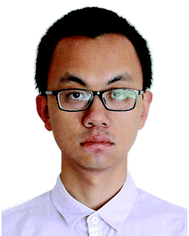Materials Horizons Emerging Investigator Series: Tianyi Ma, Swinburne University of Technology, Australia
Tianyi Ma received his PhD in physical chemistry in 2013 from Nankai University, China. He then worked as a postdoctoral research fellow from 2013 to 2014 at the University of Adelaide, Australia. He was awarded an Australian Research Council (ARC) Discovery Early Career Researcher Award (DECRA) in 2015, then worked as a senior lecturer and group leader in the department of chemistry at the University of Newcastle from 2017 to 2020. He then joined Swinburne University of Technology as an associate professor. He has made significant contributions to functional materials for photocatalysis, electrocatalysis, and piezocatalysis. He has published over 170 refereed papers (75 as the corresponding author and 24 ranked as ESI Highly Cited Papers) in high impact journals such as J. Am. Chem. Soc., Angew. Chem. Int. Ed., Adv. Mater. and Nat. Commun., giving a total citation of >14
![[thin space (1/6-em)]](https://www.rsc.org/images/entities/char_2009.gif) 000 and an H-index of 51. He has secured >$2.4 million research funding from the Australian Research Council (ARC), Commonwealth Scientific and Industrial Research Organisation (CSIRO) and industry partners. In recognition of his research excellence, he has been awarded the ESI Highly Cited Researchers (Clarivate, 2020), Journal of Materials Chemistry A “Emerging Investigators” status (Royal Society of Chemistry, UK, 2018), and a TANG Auchin Chemistry Scholarship (Jilin University, China, 2012).
000 and an H-index of 51. He has secured >$2.4 million research funding from the Australian Research Council (ARC), Commonwealth Scientific and Industrial Research Organisation (CSIRO) and industry partners. In recognition of his research excellence, he has been awarded the ESI Highly Cited Researchers (Clarivate, 2020), Journal of Materials Chemistry A “Emerging Investigators” status (Royal Society of Chemistry, UK, 2018), and a TANG Auchin Chemistry Scholarship (Jilin University, China, 2012).
Read Tianyi Ma's Emerging Investigator Series article ‘In situ identification of the electrocatalytic water oxidation behavior of a nickel-based metal–organic framework nanoarrays’ and read more about him in the interview below:
MH: Your recent Materials Horizons Communication is an exploration of the electrochemical water oxidation behavior of a Ni-based MOF nanoarray to identify the true active site for the OER process. How has your research evolved from your first article to this most recent article, and where do you see your research going in the future?.
TM: My first article was published in 2008 (J. Phys. Chem. C, 2008, 112, 3090), which was a study on the synthesis, photocatalytic activity, and heavy metal ion adsorption of macroporous titanium phosphonate materials. Although that work achieved good catalytic activity, there was a less in-depth study of the catalytic active sites at that time. The main reasons were the failure to construct an appropriate structure and the lack of reliable characterization technologies. It was 13 years ago… However, the work inspired my enthusiasm for the research of catalytic reaction mechanisms. After that, I became very interested in materials with tunable chemical structures (e.g. MOFs) and ordered networks (e.g. nanoarrays) and applied these materials extensively in my research. These materials not only help to construct a reaction environment that can be compatible to theoretical simulations, but also can be easily combined with advanced in situ characterization techniques to reveal the active sites of electrocatalytic reactions accurately. This latest article is the most representative one in my series of research work. We will also use this method to study the catalytic mechanism of various electrocatalytic reactions (e.g. OER, ORR, HER, N2RR, CO2RR) in the future.
MH: What aspect of your work are you most excited about at the moment?
TM: I am excited about the new experimental phenomenon that is different from the previous reports in the designed catalyst system. I think these new experimental phenomena can expand our understanding of the catalytic mechanism. Also, understanding the reaction mechanism from the atomic level is amazing, as it allows us to see the truth of materials science.
MH: In your opinion, what are the most important questions to be asked/answered in this field of research?
TM: In my opinion, one of the most important questions to be asked in this field is how to push these promising electrocatalysts into practical applications. This is a problem that requires multi-faceted collaboration, including further improving the conductivity of materials, enhancing the mechanical and chemical stability of catalysis, and exploiting integrated strategies for mass production.
MH: What do you find most challenging about your research?
TM: I think the research to reveal the active sites of electrocatalysts has been full of challenges. This requires the construction of a reliable catalyst model and the help of advanced in situ characterization techniques and theoretical calculations.
MH: In which upcoming conferences or events may our readers meet you?
TM: The International Conference on Nanomaterial and Atomaterial Science and Applications (ICNASA), Melbourne, Australia.
Estimated to be on 1-October 2021.
MH: How do you spend your spare time?
TM: I like to watch science fiction movies with close friends. My favourite is “Edge of Tomorrow”. Science fiction actually gives us ideas for research.
MH: Can you share one piece of career-related advice or wisdom with other early career scientists?
TM: Early career scientists need to stay open-minded when they encounter problems that they are very interested in but cannot solve independently, because this may be the most important scientific problem that motivates you. I also recommend that early career scientists attend meetings and establish long-term cooperative relationships with scientists in the field.
| This journal is © The Royal Society of Chemistry 2021 |

